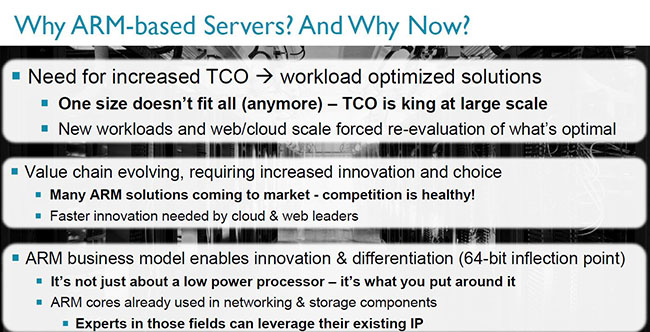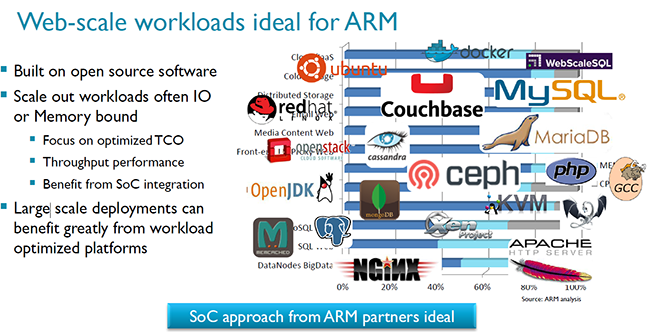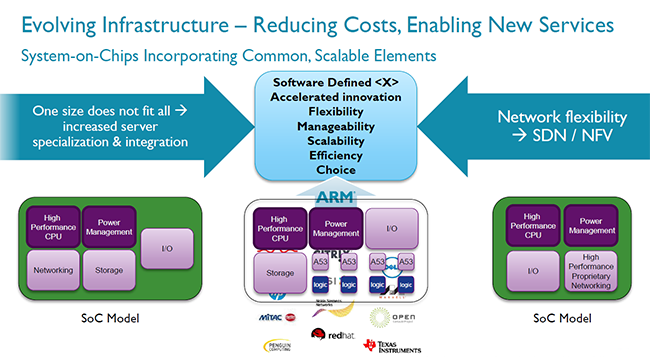ARM is best known as the company behind the CPU architecture that powers the vast majority of the world's smartphones and tablets. This is because ARM's reduced instruction-set computing (Risc) architecture, which uses small, optimised instructions, is an ideal fit for energy-efficient processing - a must for mobile devices. Though ideally designed for mobile, there are now compelling reasons why ARM's instruction-set architecture can be used for a number of server/datacentre applications.
The backbone of ARM's appeal in the entry-level server space stems from the introduction of the ARMv8-A Architecture, announced in October 2011 and now implemented in high-end processors such as the Cortex-A57 and Cortex-A53. ARMv8-A's standout feature is 64-bit support, known as AArch64, though supporting hardware can also process 32-bit instructions. Want to play in server? You absolutely need 64-bit hardware and software support.
The right (SoC) hardware for new applications
In the main, ARM is going up against Intel's x86 architecture in the server space. Serendipitous with ARM's focus on this market is the way that the datacentre is changing to accommodate some of today's newer requirements. There's a nascent, growing need for servers to handle memcache, cold storage, web-scale and an increasing number of I/O duties - the kinds of optimsed workloads used by companies such as Facebook and Google.
Making the most of its architecture, ARM says its Risc design is primed to handle these kinds of applications because system-on-chips (SoCs), built around its IP by other companies, can handle these I/O-intensive, compute-light apps just as well as x86 (Intel) chips can, though at a lower power footprint and, importantly, at a substantially lower total cost of ownership (TCO). Lower power and lower cost are the terms datacentre owners want to hear.
Putting it another way, SoCs are now being built with workloads very much in mind, not the other way around; it's workload-specific customisation, rather than the Intel one-fits-all approach, which ARM and its partners are keen to talk about.
Yet thinking of a server chip as merely a collection of cores isn't doing it justice. There's little denying that sheer horsepower is important in many applications, but a modern-day server SoC needs fast, low-latency links to the rest of the system. The surrounding I/O fabric is arguably equally as important, enabling the cores to operate with fewer restrictions, and it's one area where the ARM 'DIY' approach is more flexible than Intel's - upcoming ARM server SoCs will typically have multiple 10 Gigabit Ethernet ports and more PCIe lanes than competing Intel products.
And, evaluating it in a wider sense, because ARM's 64-bit architecture is built on a foundation of energy efficiency, ARM-based SoCs are obvious candidates for hyperscale computing, where thousands of smaller, efficient processors combine in a single rack to offer massively increased I/O capability.
Software and platform are just as important, if not more
Having suitable hardware is only part of the server puzzle that ARM and its partners are trying to solve, thus tempting datacentre owners to consider adopting their hardware over Intel's. Compatible software is equally important, underscored by the symbiotic relationship with Android on mobile-optimised processors. On the server side, recent announcements from Ubuntu (14.04 LTS release) and Red Hat, amongst others, have baked-in support for ARM's 64-bit architecture. Interestingly, Citrix believes its Xen virtualisation software runs with lower overhead on ARM hardware than on Intel.
ARM understands that creating a compelling server/datacentre solution is more than marrying hardware and software. To this end, ARM has drafted the Server Base System Architecture (SBSA) platform that defines minimum specification standards for better interoperability. This can be thought of as another part of the jigsaw that ARM's ecosystem needs to complete before being taken seriously by the server market.
Can the ARM ecosystem compete in entry-level servers?
ARM faces the same kinds of problems and challenges creating long-lasting incursions in the server space as Intel has already experienced when trying to break into mobile. Both companies are up against a strong, well-connected incumbent, who has established ties with customers that run deep. ARM partners' 64-bit server strategy is to tap into datacentre applications that benefit from running on highly-customised, highly-parallel, energy-efficient and cheap(er) hardware than is currently available today from Intel.
Initial validation of ARM in the datacentre is likely to be rubber-stamped when a mega-company such as Google and Facebook takes the ARM v8-A Architecture on and designs a fully-custom SoC around it. Such validation should pave the way for acceptance that ARM-based hardware can be a good fit for certain server applications that are I/O-bound. HP, too, has seen the promise of ARM-based servers and built select Moonshot cartridges around it. ARM is hoping that, within five years, its partners will have a 40 per cent share of the webscale market. That's no small potatoes, mind you, as it's worth around $10bn, according to estimates.
ARM appears to have many of the parts - hardware, software, implementation, partner alliances - required for completing the entry-level server jigsaw and providing a genuine alternative to the x86-dominated market. Though it would be remiss to say that ARM and its partners are going to take over the space from Intel any time soon, at least, in the middle of 2014, they do have a fighting chance in providing much-needed competition.
















